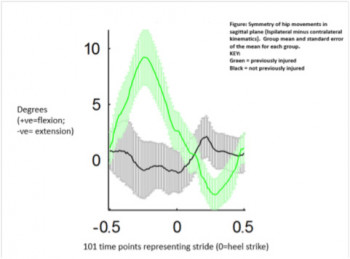Project
Hamstring Associated Movement and Muscle activity deficits following Injury (HAMMI)
| Primary Investigator: | Colm Daly |
| Co-investigators: | Dylan Morrissey |
| Roger Woledge |
The aim of the HAMMI project is to identify biomechanical features (muscle activity and movement characteristics) associated with prior hamstring injury. The key impact of this research is to develop screening strategies for hamstring re-injury prevention. To date observational measures of 3D kinematics and multiple muscle EMG activity during high speed running have highlighted key, novel and injury specific changes in muscle function and asymmetries in kinematics during clinical relevant phases of gait in previously injured athletes. These findings suggest neuroinhibition of hamstring muscle which persist beyond return to sporting function and are in agreement with emerging theories.
Currently a small cross faculty research group of Sports Medicine and Engineering students is investigating the mechanisms underlying the positive effects of the Nordic exercise protocol. Using 3D motion capture, multichannel EMG arrays and force measures, this group is exploring pre and post Nordic programme changes in hamstring muscle function. Specifically we are exploring if the Nordic Programme facilitates a reversal of post-injury neuroinhibition. A secondary aim is to explore the screening potential of multichannel EMG arrays in the hamstring region.
The final phase of this project is to prospectively screen elite level footballers using the methods developed in the earlier phases of this research. Should a causal relationship between key biomechanical features and injury risk be prospectively confirmed, a powerful screening tool will be developed using the normative dataset collected throughout this research for comparison.
For a detailed overview on sprint related hamstring injury please read the article online.



